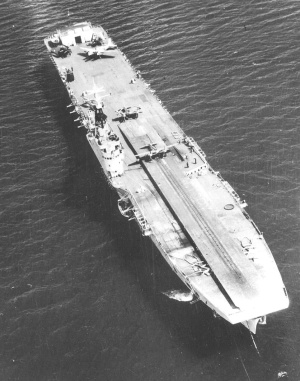Regular readers of The Engineer will have noticed that we’re following the project to build the Royal Navy’s two new aircraft carriers, HMS Queen Elizabeth and HMS Prince of Wales, with great interest. Our guest blog from the Aircraft Carrier Alliance’s chief engineer, David Downs, keeps us up to date with the latest news from the Rosyth shipyard, where Queen Elizabeth has now become the Navy’s largest ever ship.
Back in 1955, our predecessors were also following aircraft carrier developments closely, with first test of an important new technology, the steam catapult. Using steam from the ship’s boilers to act directly on the catapult itself, these had been tested aboard the carrier HMS Perseus since 1950, and had just started to be installed aboard the British and American carrier fleet.

Prior to the use of steam catapults, aircraft had been propelled into the air using a hydro-pneumatic system which used steel wire ropes to drag a small trolley along the flight deck, with the aircraft towed along behind. This was fine for the relatively small and lightweight aircraft carried by naval vessels in World War II, but with the advent of jet engines, carrier-borne aircraft became heavier and needed to be launched at greater speed. For a while, naval architects just increased the power of the hydrodynamic system, but the heavier aircraft — along with the heavier cables and pulleys — meant that eventually the catapults were growing too large to be installed even on the biggest ships.
Steam, because it shot the shuttle to which the aircraft was attached directly along the flight deck rather than relying on cables, had the advantage of transferring more energy to the aircraft while being both lighter and less complex than the previous system, with fewer moving parts. The tricky problems in metallurgy involved in ensuring the steam cylinders were stong enough to cope with the pressure needed to launch an aircraft was carried out in West Drayton and Rosyth, not far from where the new carriers are taking shape.
Steam catapults held sway on aircraft carriers for decades, and are only now being replaced by electric systems which use linear motors to accelerate the aircraft. However, after a great deal of political to-ing and fro-ing, the Royal Navy’s new carriers will have no catapults at all, with vertical and short take-off and landing (STOVL) aircraft capable of leaving the flight deck under their own power.
Later in the same issue, The Engineer discusses the matter of new weapons for the Royal Navy, in particular whether nuclear weapons should be entrusted to the Royal Air Force or the Navy. At the time, the US had started building carriers to launch heavy medium-range bombers, and there was some question of whether the UK should follow suit (it being unthinkable at the time that The Bomb could be launched from anything other than an aircraft, because only air-launched missiles were reliable enough at long range).
Our predecessors concluded that the deterrent was best off in the hands of the Air Force, and that smaller aircraft carriers were necessary. ‘No longer is it mecessary to think in terms of trhe 36,800-ton Ark Royal, laid down during the war and now being completed at a cost which will probably work out at about £24million,’ our report says. Smaller craft of the Hermes class, displacing some 18,000 tons, ‘are in no way inferior to the Ark Royal in any operational role,’ it says; three of these, rather than one larger ship, would be needed. ‘Moreover, these medium-sized vessels cost about £10,500,000 to build, which is not an exorbitant price to pay these days for ships that form the striking power of the Navy.’
Time for some comparison here. HMS Queen Elizabeth displaces 64,600 tons, and its cost is now estimated at £3.5billion (£7billion for both carriers).




Project to investigate hybrid approach to titanium manufacturing
What is this a hybrid of? Superplastic forming tends to be performed slowly as otherwise the behaviour is the hot creep that typifies hot...